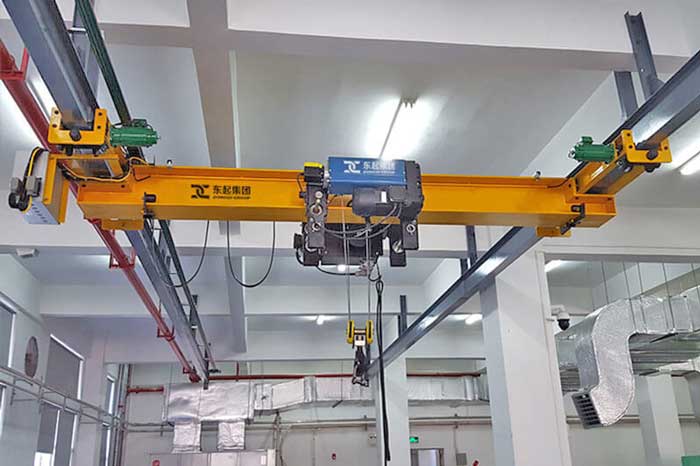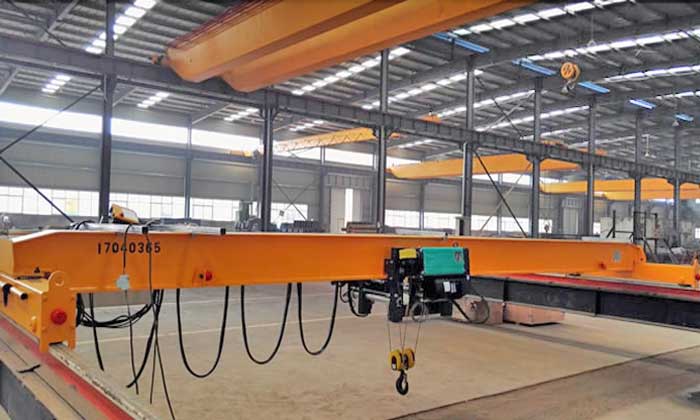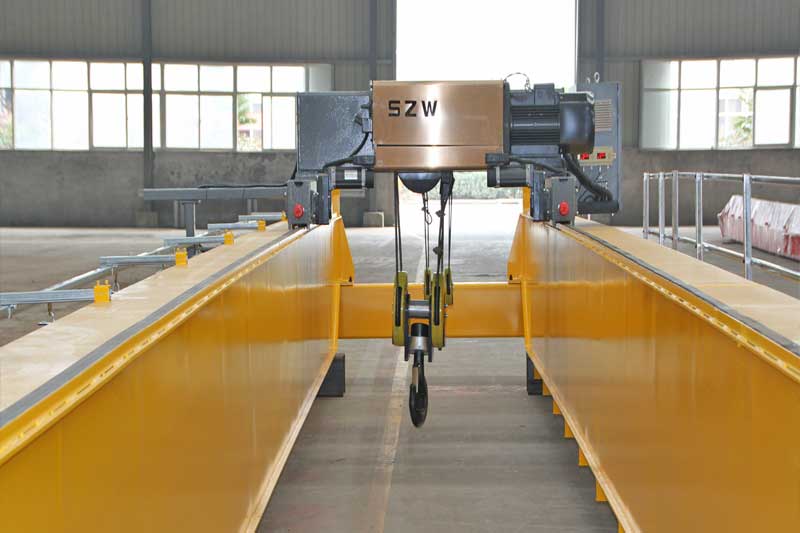Types of Overhead Cranes in China – Which One Is Right for You?
Explore different crane types in China and find the best fit for your workshop, load capacity, and space requirements.
Introduction to Overhead Cranes
Overhead cranes, also known as bridge cranes, are powerful lifting machines that move materials across a workshop or industrial facility. They run along tracks mounted on the ceiling, making them ideal for lifting heavy loads with precision. These cranes have a hoist system that can move loads vertically and horizontally, making them essential for efficient material handling.
Importance of Choosing the Right Type for Your Application
Choosing the right overhead crane is crucial. If you pick a crane that doesn't fit your specific needs, you could end up wasting time, money, and space. The right crane will make your operations smoother, faster, and safer. It’s all about matching the crane to your workshop's size, load requirements, and work environment.
When selecting a crane, consider:
- The weight and size of the items you need to lift
- How often you’ll be using the crane
- Your available space (ceiling height and layout)
- Whether you need special features, like explosion-proof or electromagnetic capabilities
Overview of China’s Crane Manufacturing Industry and Yuantai Crane's Role
China is one of the world’s leading crane manufacturers. With a strong reputation for building high-quality and reliable equipment, Chinese manufacturers meet the demands of both local and international markets. Yuantai Crane stands out in this industry. We are known for delivering customized overhead crane solutions with CE and ISO certifications.
Our experience spans many industries, from steel mills to logistics centers, making us a trusted partner for all kinds of lifting needs. Whether you need a simple workshop crane or a specialized, heavy-duty model, we have the expertise and equipment to deliver.
Top-running vs. Under-running Cranes
Top-running Cranes: Benefits and Applications
Suitable for Larger, High-Capacity Operations
Top-running cranes are ideal for heavy-duty applications. They are designed to handle large and heavy loads, making them perfect for industries like steel mills, construction sites, and large warehouses. If your operation requires lifting heavy machinery or large materials, a top-running crane is the go-to choice. They can span wider distances and lift higher loads compared to under-running cranes.
Installation Considerations
Top-running cranes need more installation space. Since they run on tracks mounted on the ceiling, the crane itself will be positioned on the top of the rails. This means that they require a higher ceiling, usually with more structural support. Before installing, ensure that your facility has enough headroom and the right structure to support the crane. They also require precise installation to ensure smooth operation.

Under-running Cranes: Benefits and Applications
Ideal for Smaller Workshops with Low Ceilings
Under-running cranes are perfect for workshops or facilities with lower ceiling heights. Unlike top-running cranes, they run on tracks installed underneath the girder, so they take up less vertical space. This makes them a great choice for smaller buildings where maximizing headroom is essential. They are commonly used in light to medium-duty operations, such as in small factories or maintenance workshops.
Advantages of Space Optimization
One of the main benefits of under-running cranes is their ability to optimize space. Since the crane operates below the beams, it allows for better usage of the space above the crane. This can be a game-changer in workshops with limited headroom. Not only does this help maximize the available vertical space, but it also ensures smoother operation in cramped areas where every inch counts
Single Girder vs. Double Girder Cranes

Single Girder Overhead Cranes: Features, Benefits, and Applications
Cost-effective and Suitable for Lighter Loads
Single girder cranes are more affordable and ideal for handling lighter loads. They are built with one horizontal beam (the girder) supported by two end trucks, making them simpler and cheaper to manufacture. This makes them a great option for operations where the lifting requirements are moderate, such as handling lighter machinery, small parts, or assembly tasks.
Ideal for Small to Medium Workshops
These cranes are perfect for small to medium-sized workshops. They offer great performance without taking up too much space or budget. If you're working in a smaller facility and need a crane that won’t break the bank but still gets the job done, a single girder crane is a solid choice. They also work well in environments where ceiling height is limited but lifting capacity needs are still manageable.

Double Girder Overhead Cranes: Features, Benefits, and Applications
Higher Lifting Capacity and Wider Span
Double girder cranes are designed for heavy-duty applications. They have two parallel beams (girders) instead of one, allowing them to handle much higher loads and span greater distances. This makes them suitable for industries that require large-scale lifting, such as heavy manufacturing, large warehouses, or steel mills. If you need a crane for lifting heavy machinery or large, bulky items, a double girder crane provides the strength and stability needed.
Ideal for Heavy-Duty Applications in Larger Plants
Double girder cranes are the go-to choice for large, high-capacity operations. They are built to withstand more stress and provide the lifting power needed in demanding environments. Whether you're working in an industrial plant, a construction yard, or a heavy-duty manufacturing facility, a double girder crane can handle the tougher jobs. They also offer greater flexibility in terms of hook height and lifting capacity, making them ideal for larger plants with heavy lifting needs.
Special Cranes: Explosion-proof, Electromagnetic, Grab Cranes, etc.
Explosion-proof Cranes: Overview and Safety Features
- Applications in Hazardous Environments:
Explosion-proof cranes are designed to operate in environments where flammable gases, vapors, or dust are present. Commonly used in industries like oil and gas, chemical plants, and refineries, these cranes prevent ignition sources, ensuring safe operations in hazardous conditions. - Safety Standards and Certifications:
Safety is paramount in such environments. Explosion-proof cranes must meet strict international safety standards, such as ATEX (Europe) or NEC (U.S.) certifications. These certifications ensure the crane has been designed and built to prevent sparks or heat that could cause explosions, making it essential to choose cranes from certified manufacturers for safety and reliability.
Electromagnetic Cranes: Benefits for Material Handling (Steel Billets, etc.)
- Ideal for Metal Handling:
Electromagnetic cranes are perfect for lifting ferrous materials like steel billets, scrap metal, or iron. Equipped with strong electromagnets, they offer an efficient way to move large metal objects without additional lifting gear, such as slings or hooks. This makes them especially useful in steel mills, scrap yards, and recycling centers. - Improved Efficiency in Material Handling:
These cranes streamline the lifting process by allowing quick, safe, and efficient movement of heavy metal materials. Electromagnetic cranes help improve operational productivity while minimizing manual handling risks, making them an essential part of industries handling large volumes of metal.
Grab Cranes: Features and Typical Applications
- Handling Bulk Materials (Coal, Sand, Gravel, etc.):
Grab cranes are designed for bulk material handling in industries like mining, construction, and ports. These cranes use a mechanical grab bucket to scoop, transport, and release loose materials such as coal, sand, and gravel. The grab bucket opens and closes, allowing for controlled loading and unloading of bulk items. - Flexible and Efficient Material Handling:
Grab cranes are versatile in handling a variety of loose materials, improving the efficiency of bulk transport. Depending on the application, they can be equipped with different types of grabs—single or double clamshells—to handle different material types effectively. This makes them ideal for tasks that require moving large quantities of material, even in harsh conditions.
Steel Mill Cranes
Steel mill cranes are specifically designed for heavy-duty operations within steel manufacturing plants. These cranes handle large, heavy materials, such as billets, slabs, coils, and ingots, often under extreme conditions like high temperatures. Steel mill cranes come in several types, including:
- Overhead Cranes for lifting heavy steel products.
- Portal Cranes for more precise material handling.
- Ladle Cranes for moving molten metal.
These cranes must be durable, efficient, and capable of operating under intense conditions. Safety features, such as thermal protection and high-duty cycle designs, are crucial for working in high-temperature environments like steel mills.
Buyer Tips: How to Choose Based on Your Workshop and Load
Assessing Your Workshop Layout and Ceiling Height
When selecting a crane, the layout of your workshop is a crucial factor. Here’s what to consider:
- Ceiling Height:
The height of your workshop directly impacts your crane selection. If you have a low ceiling, you might need to opt for an under-running crane, as these are designed to operate within limited vertical space. On the other hand, top-running cranes require more headroom, making them ideal for larger workshops with higher ceilings. Always measure your ceiling height before deciding on a crane. - Available Space:
The available space in your facility should guide your crane’s design. If your workshop is tight or has narrow aisles, a more compact crane, like a single girder or under-running crane, may be the best fit. These cranes take up less space while still offering reliable performance for lighter loads. Ensure there’s enough room for the crane to move freely and safely, without obstacles or interference.
Determining Load Capacity and Frequency of Use
Choosing the right crane depends on how much weight you need to lift and how often the crane will be in use.
- Load Capacity:
The lifting capacity of the crane should match the maximum weight you plan to lift. It’s important not to under- or overestimate the required capacity, as this could impact both the crane’s performance and safety. For lighter tasks, a single girder crane may be sufficient, while heavier loads (such as those in steel mills or construction) may require a double girder crane for increased lifting power. - Frequency of Use:
If your crane will be in constant use, it’s essential to choose one built for heavy-duty operation, like a double girder crane or an electromagnetic crane for material handling. If your crane will be used occasionally for lighter tasks, a single girder crane may be more than enough. Think about the intensity of your operations and choose a crane that can handle the workload efficiently.
Considering Future Expansion or Upgrades
Your business may grow over time, and it’s important to think ahead when choosing your crane.
- Flexibility and Scalability:
When selecting a crane, consider how your needs might change in the future. For example, if your workshop grows or your lifting needs increase, you may need a crane that can handle more weight or span a larger area. A double girder crane offers more flexibility in terms of load capacity and span, making it a good choice if you anticipate growth. - Upgrading Capabilities:
Some crane systems can be easily upgraded to meet increasing demands. For example, you might start with a smaller, lighter crane but leave room for future upgrades, such as a larger hoist or additional features. Choose a crane that can adapt to potential expansions, ensuring it remains useful as your business grows.
By considering these factors, you can make an informed decision that suits both your current and future needs, ensuring that your crane will be an efficient, long-term investment for your operations.
Ready to Choose the Perfect Crane for Your Workshop?
At Yuantai Crane, we understand that selecting the right crane is crucial for your business’s efficiency and safety. Our team is here to help you make the best decision based on your specific workshop size, ceiling height, load requirements, and long-term goals.
Why Choose Yuantai Crane?
- Expert Guidance: With years of experience in crane manufacturing and installation, we offer tailored advice to match your unique needs.
- Customer Support: Our team is dedicated to providing continuous support before, during, and after your crane installation, ensuring smooth operations and reliable performance.
- Quality and Reliability: We offer top-quality, customized cranes that meet international standards and certifications, ensuring your investment is secure.
Contact Us Today!
Reach out now to get a personalized recommendation based on your workshop size and lifting needs. Let Yuantai Crane help you find the perfect crane solution for your business!




